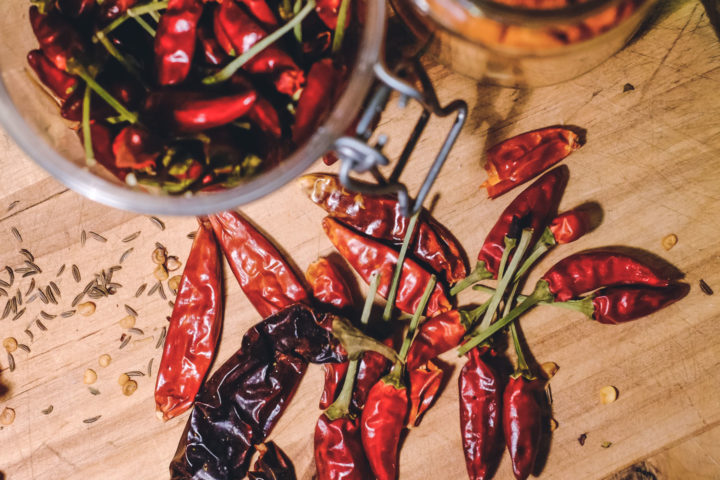Understand Spiciness: A Pain but Not a Taste
By Roshni Printer

You must have experienced the aftermath of a bowl of spicy ramen, a dollop of wasabi, a bite of chili pepper. Your tongue feels like it’s on fire; your eyes start watering, and you begin to sweat through your clothes. No other sensation would come close to the overwhelming sensory experience that comes with spiciness. Here is an interesting fact: Spiciness is not a taste, but rather a sensation of pain. Then, why does spiciness intrigue humans so much that we would prepare food “so tasty it hurts”?
Chili peppers contain an alkaloid compound known as capsaicin, which can trigger the burning sensation of spiciness. As we chew, capsaicin molecules are released and spread across our tongue. However, they bypass the taste pores and bind to pain receptors instead [1]. Originally functioning as a detector to alert the brain of high temperatures (>43 °C [2]), these pain receptors, by the name of TRPV1, can also be activated by capsaicin. As a cation channel by nature, TRPV1 receptors will open when activated, so cations can diffuse into the nociceptive (pain-sensing) neurons [3]. The increase in electric potential, known as depolarization, will trigger the neuron to fire and send a signal to the brain. Our brain will then interpret the signal and think that our tongue is in contact with a burning hot substance, giving us the false impression that our mouth is on fire.
If spiciness truly is a sensation of pain, why will we have the urge to go back for one last bite? Here’s where our body’s self-regulatory mechanism comes into play. After perceiving that we are in pain, hormones like endorphins, which are known as the natural painkillers and the “feel-good” hormones of the body, are released [4]. These hormones also increase the level of a neurotransmitter, dopamine, making us feel even more pleasant and euphoric [4]. Therefore, the secret behind our addiction to spiciness is, in fact, the “feel-good” chemicals that give us a light-hearted rush.
If your first instinct when your mouth is “on fire” is to grab a glass of water, think again! Capsaicin is a hydrophobic (“water-hating”, or “fat-loving”), non-polar molecule with a long hydrocarbon tail. Drinking water will only spread capsaicin all over the tongue, and heightens the burning sensation. You should instead consume dairy products because it contains casein, a non-polar protein which can bind to capsaicin. Similar to the cleaning action of detergents to remove grease, casein molecules will surround capsaicin molecules to form tiny droplets which can then be washed away easily [5]. Hence a cup of milk, or a cone of ice cream can likely “cool off” spicy food.
Some foods may contain other compounds that can also activate TRPV1, and/or the “wasabi receptor” TRPA1, another pain receptor under the TRP family. Black peppers contain piperine [6], while mustard [7] and wasabi [8] contain compounds belonging to the class of isothiocyanates. Isothiocyanates are volatile small molecules that can be inhaled and stimulate the receptors in the nasal cavity, so mustard and wasabi can burn not only our mouth, but also our nose. Notably, this will eventually lead to the secretion of the “feel-good” chemicals as well.
Alongside its ability to elicit a sensation of pain, surprisingly, capsaicin is also used in pharmaceuticals to provide relief to pain. It is commonly sold over the counter in the form of topical ointments and patches (the pain-relieving “hot” patches) [9]. In addition, capsaisin was approved in Europe to treat neuropathic pain [10], which is often described as shooting or burning pain, resulting from nerve injury [11]. Researchers have hypothesized how capsaicin works in relieving pain, with the desensitization of TRPV1 (i.e. decreased responsiveness after repeated exposure) being one of the possible mechanisms [9].
To conclude, the spicy capsaicin molecule can give us pleasure and pain at the same time. While scientists continue to unravel the working mechanisms of capsaicin and other pungent molecules in our body, we can, at least, take the lesson and keep a glass of milk handy next time when we feast on chili peppers!
References:
[1] Nobel Prize Outreach AB 2023. Press Release: The Nobel Prize in Physiology or Medicine 2021. The Nobel Prize. https://www.nobelprize.org/prizes/medicine/2021/press-release/
[2] Caterina MJ, Rosen TA, Tominaga M, Brake AJ, Julius D. A capsaicin-receptor homologue with a high threshold for noxious heat. Nature. 1999;398(6726):436-441. doi:10.1038/18906
[3] Caterina MJ, Schumacher MA, Tominaga M, Rosen TA, Levine JD, Julius D. The capsaicin receptor: a heat-activated ion channel in the pain pathway. Nature. 1997;389(6653):816-824. doi:10.1038/39807
[4] Choy M, El Fassi S, Treur J. An adaptive network model for pain and pleasure through spicy food and its desensitization. Cogn Syst Res. 2021;66:211-220. doi:10.1016/j.cogsys.2020.10.006
[5] Rohrig B. Hot Peppers: Muy Caliente. American Chemical Society. https://www.acs.org/education/resources/highschool/chemmatters/past-issues/archive-2013-2014/peppers.html
[6] McNamara FN, Randall A, Gunthorpe MJ. Effects of piperine, the pungent component of black pepper, at the human vanilloid receptor (TRPV1). Br J Pharmacol. 2005;144(6):781-790. doi:10.1038/sj.bjp.0706040
[7] Eib S, Schneider DJ, Hensel O, Seuß-Baum I. Relationship between mustard pungency and allyl-isothiocyanate content: A comparison of sensory and chemical evaluations. J Food Sci. 2020;85(9):2728-2736. doi:10.1111/1750-3841.15383
[8] Uchida K, Miura Y, Nagai M, Tominaga M. Isothiocyanates from Wasabia japonica activate transient receptor potential ankyrin 1 channel. Chem Senses. 2012;37(9):809-818. doi:10.1093/chemse/bjs065
[9] O’Neill J, Brock C, Olesen AE, Andresen T, Nilsson M, Dickenson AH. Unravelling the mystery of capsaicin: a tool to understand and treat pain. Pharmacol Rev. 2012;64(4):939-971. doi:10.1124/pr.112.006163
[10] Chung MK, Campbell JN. Use of Capsaicin to Treat Pain: Mechanistic and Therapeutic Considerations. Pharmaceuticals (Basel). 2016;9(4):66. doi:10.3390/ph9040066
[11] Jardín I, López JJ, Diez R, et al. TRPs in Pain Sensation. Front Physiol. 2017;8:392. doi:10.3389/fphys.2017.00392